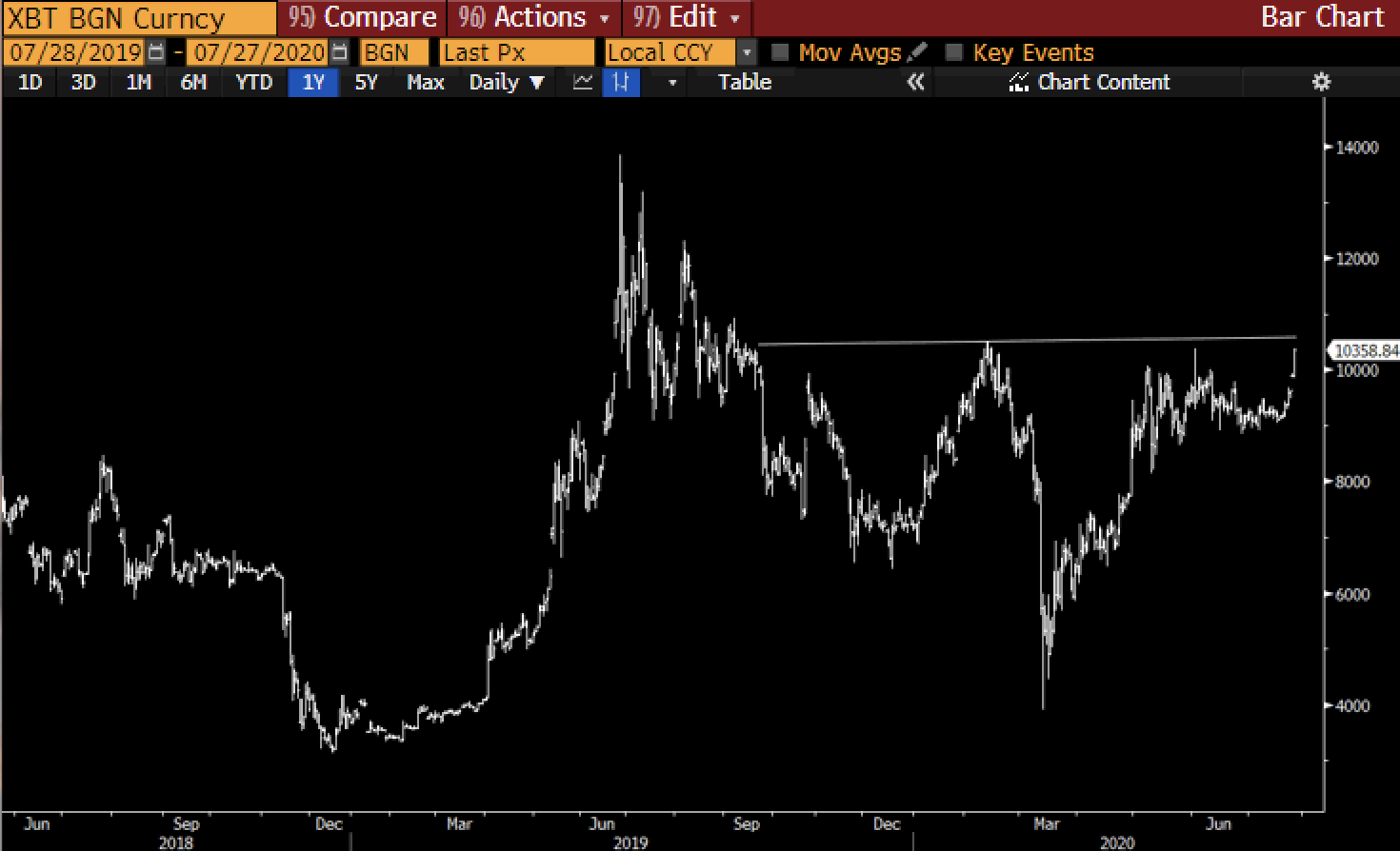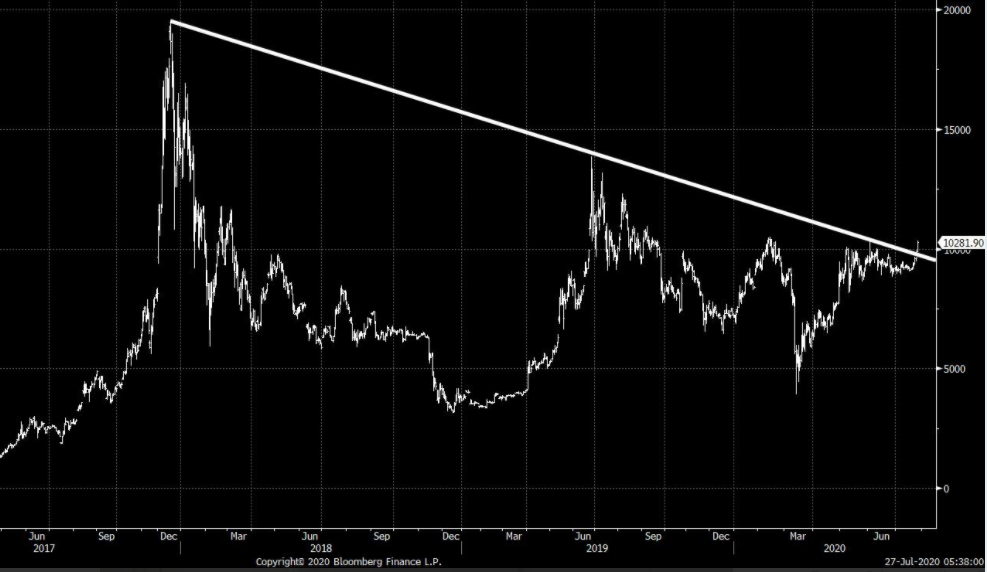Have you been enjoying the weather, Reader?
It’s been a damn rainy few days here in London – though it sounds like it’s the rest of the country that’s really got drookit.
I must confess dear Reader, I’ve been loving the rain. Feels like it’s been ages since we’ve had a decent downpour, a nice storm to wash off all the stagnant heat of days past and rain against the windows at night.
My local park back home in Aberdeen has flooded, my mother tells me – monsoon-like rains she says.
There’s definitely been some flash-flooding in niche markets over the last few days. We mentioned bitcoin surging yesterday – it kept on going up and stands at $10,800 at the time of writing. There have been some interesting charts published by market commentators illustrating how important this recent surge might be.
Raoul Pal, the macro investor, put this chart up prior to the surge, saying that the critical level that BTC must pass to surge higher is $10,500, a level it has been unable to pass since midway through last year:
 Click to enlarge
Click to enlarge
Source: @RaoulGMI, on Twitter
Joe Weisenthal at Bloomberg posted this chart on Twitter (I’ve cropped it to make it clearer), drawing a line from the 2017 peak down across all the later peaks. As you can see on the far right, this latest surge has broken that trend, which fills the mind with all manner of bullish notions.
 Click to enlarge
Click to enlarge
Source: @TheStalwart, on Twitter
The volatility of bitcoin, its possibility of rapid riches, can make people (myself included) very excited when they see a sudden surge. The anticipation of a monsoon of further price gains jumps to the forefront of the imagination and lingers there. It’s a hook which few can or want to shrug off.
A fund manager interviewed me a few weeks back on bitcoin and crypto, wanting to get a stronger grasp on the basics and learn more about its potential applications (and its weaknesses). He described how he saw a “macro tailwind” for BTC, as monetary debasement and the expansion of the internet are moving in tandem right now.
He certainly picked a good time to get interested in the space. I wonder how many others in the fund management industry might be curious like him, as ever more of our fundamental assumptions about money, debt, and value are challenged on a daily basis.
There’s been a flash flood in the “hard money” market though as well. At 3 o’clock this morning, silver hit an incredible $26 an ounce (cresting £20 here in the UK) before falling sharply to $23. We haven’t seen levels like $26 per troy ounce on a sustained basis since early 2013, and that was while silver was crashing. For it to be poking those prices now, and so rapidly, is suggestive that good times are on the horizon for silver bugs; that from this sudden rainfall, green shoots will spring…
The of course, is the other market monsoon which James Allen’s readers have been making such a mint from: the change in the weather from oil to the renewables sector. If you want to get a glimpse of where that wind is blowing, you can find out more here.
When the levee breaks?
But outside these market monsoons, the actual monsoon this year has been causing significantly more havoc, and is a reason for investors to be cautious.
The Three Gorges Dam in China, the enormous mega-construction some 1.4 miles long, has become becoming visibly disfigured by the force of water pressing upon it. The dam blocks off the Yangtze river, China’s largest, and due to the heavy rain this monsoon season, some 400 of the rivers which flow into the Yangtze have flooded.
Chinese Communist Party (CCP) officials have said this is the worst flooding in a century. Others have said 1998. But whatever the case, anything which can bend a concrete object reinforced by hundreds of thousands of tonnes of steel is not be taken lightly.
(There has been lots of arguing over the internet as to whether the aerial photos of the dam bending under the strain were doctored, but Chinese state news has confirmed that the dam has been “deformed”, and parts of the dam have buckled.)
What a failure of the dam would look like has been the topic of much speculation. What estimates I have seen are utterly catastrophic – a humanitarian tragedy – but I’m no engineer or geologist, so I can’t speak on the potential severity with any authority.
However, investors should keep an eye on the matter. While there’s plenty of talk now of decoupling from China, and plenty of actions being taken by companies and governments to do so, China is still an engine of growth for the global economy, with countries like Germany hugely reliant upon Chinese demand.
Broad “decoupling” is not something that can be performed overnight and plenty of companies and countries are not interested in doing so either (not yet, at least).
Even a small chance of the dam breaking is enough a risk to pay attention – the turmoil it would create within the country would further crush the domestic economy post-WuFlu and make the CCP ever more aggressive externally. And that’s if failure of the dam doesn’t lead to a catastrophe scenario, with major flooding and destruction of the other cities – and other dams – downstream.
2020, huh?
I hope you’re surviving the downpour, wherever you may be.
Back tomorrow,

Boaz Shoshan
Editor, Capital & Conflict
For charts and other financial/geopolitical content, follow me on Twitter: @FederalExcess.
Category: Market updates

